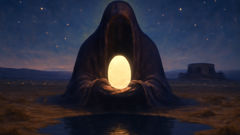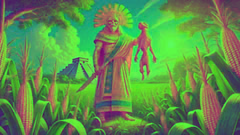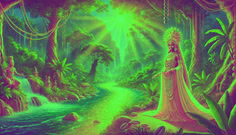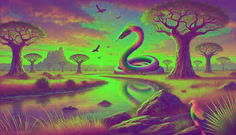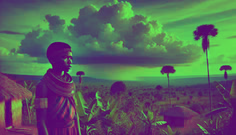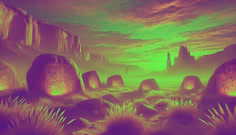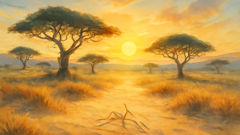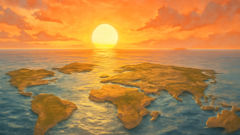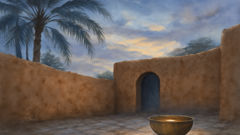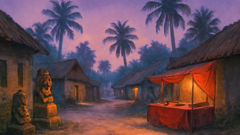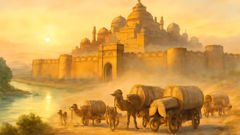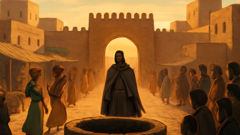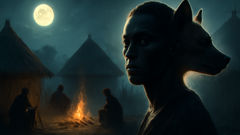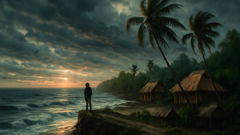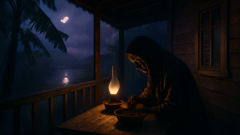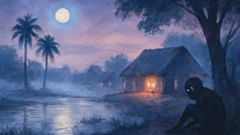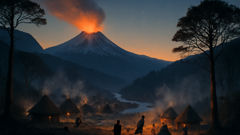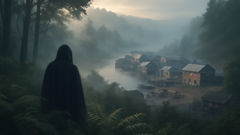Introduction
In the beginning, the world was a silence so vast it tasted of nothing. There was no river to recall, no shore to keep, no grain of sand to show where a foot had passed. Dogon storytellers say the void was not hostile; it was simply undifferentiated, like a palm leaf folded and waiting for the knife. Into that wider hush stepped Amma, the remote and watchful force—neither entirely god as we modern tongues would name nor an empty idea, but a presence that held potential like heat in stone. Amma desired pattern. From the dark quiet came intention: the shaping of an egg the size of the horizon, an orb of compressed possibility. This cosmic egg was not gentle; it was a seed of rules. Amma spun and breathed and wrapped the egg in laws of weight and measure, balancing tensions as a potter centers clay on the wheel. Within the shell, threads of being began to stitch themselves: the first waters; the first breath; something that would become speech. When the egg quivered and split, the world it birthed did not emerge whole but as a cascade—water rushing to claim valleys, air whispering into hollows, dust rearranging into hill and depression. From the cracked shell came Nommo: amphibious, luminous beings, half-syllable and half-fish, who moved like refracted light through liquid. They were both teachers and testaments, the first memory of motion and the keepers of the rhythms that would let life remember its own making. This tale is older than the stones of the Bandiagara Escarpment, older than the language of the market. It is a story of how order rose from the swelling of a silence, and how water and stars keep the memory of the moment when everything was set to begin.
The Egg and the Breath: Birth of Order
They say Amma did not rush. The first thing Amma understood was the difference between wanting and allowing. To want a world is one thing; to allow a world to be is another. Amma folded intent into the egg with the patience of someone setting a melody into a silence. The shell was mapped in secret syllables—lines that would become the seasons, ribs that would become rivers, and a hushed grammar that would teach stones to divide and seeds to burst. When the shell's surface trembled, the tremor was not merely a sound but a language: crack, sigh, spool of breath unspooling into the dark. From that breath came the first wind, a breath that carried the weight of Amma's thought and the freshness of what had never known a name.
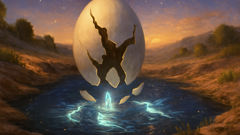
An image from the memory of the people: a pool so black it ate light, and under the weight of the egg the first water rose and trembled. The egg did not break like brittle pottery; it cleaved with a careful violence, a splitting that resembled the opening of a book whose pages had been pressed shut for an eternity. When the first fragment fell, it slid into the water and the pool answered with song. Fish of light—the earliest Nommo—uncoiled and braided themselves under the surface, scattering luminous scales like scattered seeds. They moved with the knowing of those who had been taught the rhythm of the new world, and their motion began to write the first maps upon the skin of water: eddies became names; currents became genealogies; the way light skimmed a ripple became instruction. In Dogon oral telling, they are both creature and diagram: their bodies show how the cosmos is to be read if one knows how to look. Each Nommo held within it a reflection of a star, a mirror to the firmament that Amma had set above.
Amma then fashioned elements into a conversation. Stone replied to wind by learning erosion; seed answered to sun with the patience of germination. Language, in the story, was less a tool than a consequence: after order spreads, speech arises naturally to carry it. The Nommo, amphibious beings with voices like bells and skin like watered bronze, were lenders of that speech. They moved in and out of river mouths, teaching humans to make distinctions: to mark time by the cyclical swell of flood, to store memory in clay, and to carve the sky into names. Those names matter, for in the Dogon cosmology naming is not passive. A name holds a pattern and repeats it into existence. When a child hears the river called by its proper tongue, that child is learning to remember that this river once listened to the breath of Amma. The Nommo, in turn, hungered for reciprocity—not of worship but of acknowledgment. They wanted the world to remember its origin not as a myth to be told once, but as a pulse to be lived.
This founding pulse had consequences both immediate and generative. Where the egg's shell fell, cliffs rose; where its fragments sank, fertile lagoons formed whose depths kept the luminous secret of the first stars. People learned to read the reflection of constellations in calm waters; the sky's pattern and the pool's echo reinforced each other. A fisherman watching a still river at dawn could trace a star's movement in the way morning light warmed the water's lip. Rituals grew out of these daily acts of remembering: offerings tossed into eddies became a reply to the originary motion; songs hummed at wells acted as small ammas, re-creating intention in miniature. Over generations these tiny acts wove themselves into culture, creating durable forms—ceremonies, masks, carved doors—through which the community would perpetually bring itself back to the place where silence became speech. The egg's fracture, therefore, is not an event frozen in time but an instruction manual for living. By tending water and repeating names, the people keep the world in alignment with that first deliberate split. The myth teaches that order is not final; it is a responsibility.
Nommo, Water, and the Memory of Stars
Nommo are more than origin beings: they are mnemonic devices made of breath and water. Their bodies bridge two textures—the wetness that makes life possible and the illumined aspect that links to the sky. In the telling of Dogon elders, the Nommo's scales are dotted by the impression of galaxies; when they move, constellations tremble as if being read aloud. People speak of the Nommo as teachers who taught ritual geometry, how to align houses with celestial nodes, how to measure time by the incline of Sirius and the swell of the Niger. But to say the Nommo were only teachers is to miss the sorrow and the humor woven into their nature: they were mischievous in the way of those who remember origin without needing to be constantly reminded. Their advice was precise; their timing, cryptic.
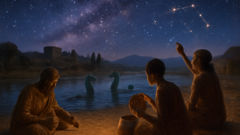
The Nommo's relationship with water is central not only because they emerged from it, but because water itself carries memory. Water remembers motion better than stone remembers weight. It keeps the record of flow in a moving script; eddies are punctuation marks and flood pulses are long sentences. In villages where storytellers speak the tale, elders point to wells and marshes as living archives. When a child dips a hand into a well and lifts it to their face, they are touching an archive that has been touched by countless hands before. Water is thus both repository and teacher. The Nommo taught people to listen to water's syntax: how the texture of a current foretells drought or abundance, how the taste of a pool can denote salt and migration, how the murmuration of surface insects marks the presence of deep, patient life below.
As the myth progresses, the star-stitching becomes explicit. Amma, after setting the egg and shaping the Nommo, pinned certain stars as long-term witnesses. Not all stars are equal in memory; the Dogon cosmology famously centers Sirius and other bright points as nodes in an order. These celestial bodies are imagined to carry the imprint of the egg's pattern; they are, the story says, the long shadows of Amma's fingers. The Nommo taught human beings to read these fingerprints by showing them how the stars are reflected in water. When night makes the surface of a river like a second sky, the two maps overlay and create a lesson: what is above is mirrored below, and to know one is to know the other. Farmers and potters learned to orient themselves by these double-maps: a particular star's rising aligned with the watering of fields, and a certain reflection in the lagoon signaled the right moment to cast pots that would hold both grain and story. Thus, utensils and fields become instruments of remembrance; the mundane is sacramental.
But memory is a precarious thing. The myth does not promise unbroken continuity. Memory must be tended, lest it become myth alone—beautiful but inert. This is where human choice enters the weave. People may forget names, change rites, misread the reflection in a puddle. When that happens, the Nommo sometimes act like midwives and sometimes like stern schoolmasters. They return in dreams as wet figures, offering corrections in the form of sudden insights or sudden floods that realign communities with their ancient rhythms. And in other retellings they depart, injured by human arrogance, returning only when humility is restored through humble ceremonies: the washing of hands, the mending of nets, the learning of a child's proper name. The story thus demands humility: the world is not ours to claim, but ours to remember. If we keep the memory of the egg and the movements of the Nommo, then the stars themselves will continue to speak back. If not, the pattern fades and chaos reasserts a whispering claim.
In the final passages of the telling, the Dogon do not ask for blind faith but for embodied practice. The myth prescribes small acts—carving the right angle on a lintel, planting a tree in the direction of a forgotten star, offering a handful of millet to the edge of a canal—that collectively become a living archive. The extraordinary here is the seamlessness between cosmology and craft; artisanship becomes worship and navigation becomes prayer. Through these daily acts the people maintain an active correspondence with Amma's original intention. Water continues to memorize the strokes of creation, and the Nommo, ever patient, keep whispering the names of stars into the ears of those who will bend close enough to listen. What the story teaches most penetratingly is that remembrance is not a single act of looking back but an ongoing practice of aligning breath with river and song with sky, perpetually re-creating the condition for order to remain.
Conclusion
So the myth ends not with a tidy closure but with a charge: to act as stewards of remembrance. The Dogon story of Amma and the cosmic egg teaches that the world is a conversation between silence and pattern, and that human hands and voices are part of the ongoing grammar. Water, which remembered the first stirrings, continues to hold a living archive in its flow; stars, planted above as witnesses, keep the original geometry visible if anyone cares to trace it. Nommo remain the intermediaries—harbingers of instruction, embodiments of amphibious memory—reminding communities that to live well is to attend carefully to ritual, craft, and the names that bind them to origin. This is not a myth that merely answers the question 'How did things begin?' It is a myth that asks a continuing question: 'How will you remember?' And in asking, it teaches a practice. Through small, deliberate acts—mending, naming, offering, and listening—the ordinary becomes sacred and the night becomes a text. The creation is ongoing because memory is ongoing. If people keep tracing the stars in river water, if they keep teaching children the names of rivers and constellations, then order is not a ghost of a beginning but a living present. That is the deep promise at the heart of the Dogon tale: that water and stars will hold the record of birth so long as we hold the habit of memory.

